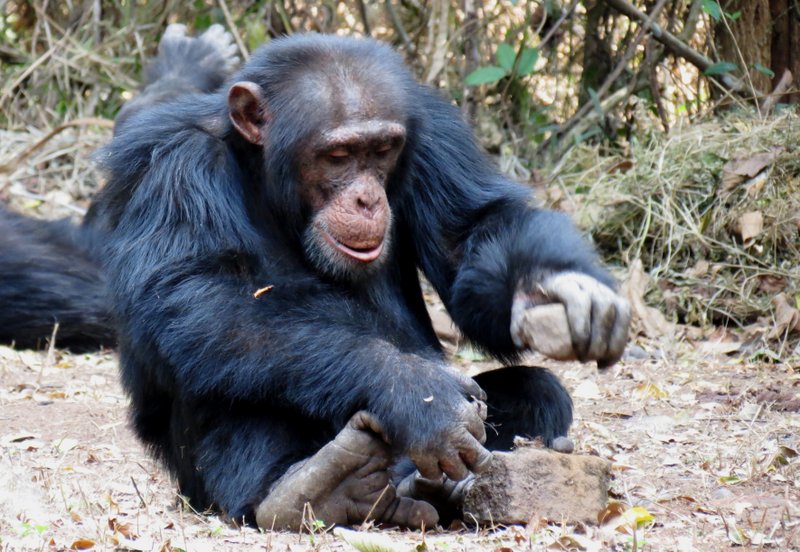
Whether you are a human being or an orangutan, tools can be a big help in getting what you need to survive. However, a review of current research into the use of tools by non-human primates suggests that ecological opportunity, rather than necessity, is the main driver behind primates such as chimpanzees picking up a stone to crack open nuts.
An opinion piece by Dr Kathelijne Koops of the University of Cambridge and others, published today (12 November 2014) in Biology Letters, challenges the assumption that necessity is the mother of invention. She and her colleagues argue that research into tool use by primates should look at the opportunities for tool use provided by the local environment.
Koops and colleagues reviewed studies on tool use among the three habitual tool-using primates – chimpanzees, orangutans and bearded capuchins.
Chimpanzees use a variety of tools in a range of contexts, including stones to crack open nuts, and sticks to harvest aggressive army ants. Orangutans also use stick tools to prey on insects, as well as to extract seeds from fruits. Bearded capuchin monkeys living in savannah-like environments also use a variety of tools, including stones to crack open nuts and sticks to dig for tubers.
The researchers’ review of the published literature, including their own studies, revealed that, against expectations, tool use did not increase in times when food was scarce. Instead, tool use appears to be determined by ecological opportunity – with calorie-rich but hard-to-reach foodstuffs appearing to act as an incentive for an ingenious use of materials.
“By ecological opportunity, we mean the likelihood of encountering tool materials and resources whose exploitation requires the use of tools. We showed that these ecological opportunities influence the occurrence of tool use. The resources extracted using tools, such as nuts and honey, are among the richest in primate habitats. Hence, extraction pays off, and not just during times of food scarcity,” said Koops.
__________________________________
 This image shows a chimpanzee using a stone to crack a nut. Courtesy Kathelijine Koops
This image shows a chimpanzee using a stone to crack a nut. Courtesy Kathelijine Koops
__________________________________
Tool use—and transmission of tool-making and tool-using skills between individuals—is seen as an important marker in the development of culture. “Given our close genetic links to our primate cousins, their tool use may provide valuable insights into how humans developed their extraordinary material culture and technology,” said Koops.
It has been argued that culture is present among wild primates because simple ecological and genetic differences alone cannot account for the variation of behaviour – such as tool use – observed across populations of the same species.
Koops and co-researchers argue that this ‘method of exclusion’ may present a misleading picture when applied to the material aspects of culture.
“The local environment may exert a powerful influence on culture and may, in fact, be critical for understanding the occurrence and distribution of material culture. In forests with plenty of nut trees, we are more likely to find chimpanzees cracking nuts, which is the textbook example of chimpanzee material culture,” said Koops.
“Our study suggests that published research on primate cultures, which depend on the ‘method of exclusion’, may well underestimate the cultural repertoires of primates in the wild, perhaps by a wide margin. We propose a model in which the environment is explicitly recognised as a possible influence on material culture.”
___________________________________________
The opinion piece ‘Ecological conditions influence primate cultures’ is published by Biology Letters. The authors are Kathelijine Koops (University of Cambridge, Archaeology and Anthropology and University of Zurich, Anthropological Institute and Museum), Elisabetta Visalberghi (CNR, Institute of Cognitive Sciences) and Carel van Schaik (University of Zurich, Anthropological Institute and Museum).
___________________________________________
Source: University of Cambridge Press Release
___________________________________________
Just released!
The special new premium quality print edition of Popular Archaeology Magazine. A beautiful volume for the coffee table.
Travel and learn with Far Horizons.
Read about the most fascinating discoveries with a premium subscription to Popular Archaeology Magazine. Find out what Popular Archaeology Magazine is all about. AND MORE:
On the go? Get the smartphone version of Popular Archaeology as an app or as an ebook.
Popular Archaeology’s annual Discovery Edition eBook is a selection of the best stories published in Popular Archaeology Magazine in past issues, with an emphasis on some of the most significant, groundbreaking, or fascinating discoveries in the fields of archaeology and paleoanthropology and related fields. At least some of the articles have been updated or revised specifically for the Discovery edition. We can confidently say that there is no other single issue of an archaeology-related magazine, paper print or online, that contains as much major feature article content as this one. The latest issue, volume 2, has just been released. Go to the Discovery edition page for more information.






